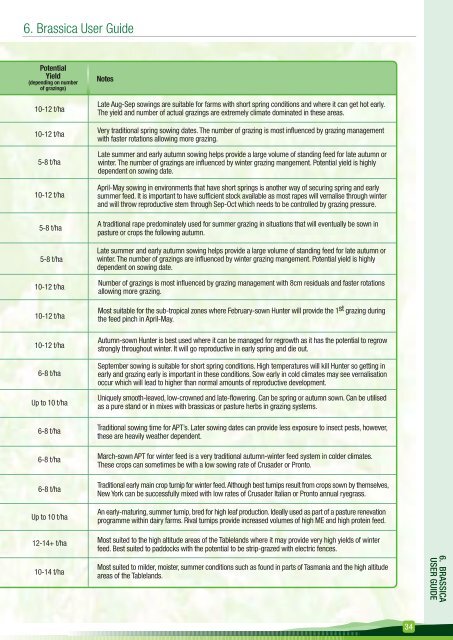Brassica Reference Manual - Agricom
Brassica Reference Manual - Agricom
Brassica Reference Manual - Agricom
Create successful ePaper yourself
Turn your PDF publications into a flip-book with our unique Google optimized e-Paper software.
6. <strong>Brassica</strong> User Guide<br />
Potential<br />
Yield<br />
(depending on number<br />
of grazings)<br />
10-12 t/ha<br />
10-12 t/ha<br />
5-8 t/ha<br />
10-12 t/ha<br />
5-8 t/ha<br />
5-8 t/ha<br />
10-12 t/ha<br />
10-12 t/ha<br />
10-12 t/ha<br />
6-8 t/ha<br />
Up to 10 t/ha<br />
6-8 t/ha<br />
6-8 t/ha<br />
6-8 t/ha<br />
Up to 10 t/ha<br />
12-14+ t/ha<br />
10-14 t/ha<br />
Notes<br />
Late Aug-Sep sowings are suitable for farms with short spring conditions and where it can get hot early.<br />
The yield and number of actual grazings are extremely climate dominated in these areas.<br />
Very traditional spring sowing dates. The number of grazing is most influenced by grazing management<br />
with faster rotations allowing more grazing.<br />
Late summer and early autumn sowing helps provide a large volume of standing feed for late autumn or<br />
winter. The number of grazings are influenced by winter grazing mangement. Potential yield is highly<br />
dependent on sowing date.<br />
April-May sowing in environments that have short springs is another way of securing spring and early<br />
summer feed. It is important to have sufficient stock available as most rapes will vernalise through winter<br />
and will throw reproductive stem through Sep-Oct which needs to be controlled by grazing pressure.<br />
A traditional rape predominately used for summer grazing in situations that will eventually be sown in<br />
pasture or crops the following autumn.<br />
Late summer and early autumn sowing helps provide a large volume of standing feed for late autumn or<br />
winter. The number of grazings are influenced by winter grazing mangement. Potential yield is highly<br />
dependent on sowing date.<br />
Number of grazings is most influenced by grazing management with 8cm residuals and faster rotations<br />
allowing more grazing.<br />
Most suitable for the sub-tropical zones where February-sown Hunter will provide the 1 st grazing during<br />
the feed pinch in April-May.<br />
Autumn-sown Hunter is best used where it can be managed for regrowth as it has the potential to regrow<br />
strongly throughout winter. It will go reproductive in early spring and die out.<br />
September sowing is suitable for short spring conditions. High temperatures will kill Hunter so getting in<br />
early and grazing early is important in these conditions. Sow early in cold climates may see vernalisation<br />
occur which will lead to higher than normal amounts of reproductive development.<br />
Uniquely smooth-leaved, low-crowned and late-flowering. Can be spring or autumn sown. Can be utilised<br />
as a pure stand or in mixes with brassicas or pasture herbs in grazing systems.<br />
Traditional sowing time for APT’s. Later sowing dates can provide less exposure to insect pests, however,<br />
these are heavily weather dependent.<br />
March-sown APT for winter feed is a very traditional autumn-winter feed system in colder climates.<br />
These crops can sometimes be with a low sowing rate of Crusader or Pronto.<br />
Traditional early main crop turnip for winter feed. Although best turnips result from crops sown by themselves,<br />
New York can be successfully mixed with low rates of Crusader Italian or Pronto annual ryegrass.<br />
An early-maturing, summer turnip, bred for high leaf production. Ideally used as part of a pasture renevation<br />
programme within dairy farms. Rival turnips provide increased volumes of high ME and high protein feed.<br />
Most suited to the high altitude areas of the Tablelands where it may provide very high yields of winter<br />
feed. Best suited to paddocks with the potential to be strip-grazed with electric fences.<br />
Most suited to milder, moister, summer conditions such as found in parts of Tasmania and the high altitude<br />
areas of the Tablelands.<br />
34<br />
6. BRASSICA<br />
USER GUIDE


